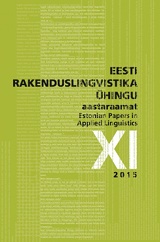Direktiivsed kõneaktid ning nende kasutamise dünaamika isa ja ema kõnes:
Directive speech acts and the dynamics of their usage in father’s and mother’s speech:
A case study
Author(s): Helen KõrgesaarSubject(s): Language acquisition, Sociolinguistics, Finno-Ugrian studies
Published by: Eesti Rakenduslingvistika Ühing (ERÜ)
Keywords: caregivers’ speech; child-directed speech; Estonian;
Summary/Abstract: The aim of the article is to give an overview of directive speech acts in Estonian child-directed speech. Two school-age children from the same family and their dialogues with both parents individually are under observation. A longitudinal study has been used as the method (one child has been regularly recorded from ages 7 to 10, the other from ages 10 to 14), including 16 hours of audio material. All directive speech acts have been singled out from the parents’ speech and classified into imperatives, hints, prohibitions, statements of an addressee’s desired actions, permissions, speaker’s wishes, suggestions, hortatives, warnings and statements of social rules. Based on the analysis, comparisons are made between the mother’s and father’s speech with regard to the usage of different types of directives, and the dynamics of using directives when the child is growing as well as in situations of communication have been examined. Although the results of the analysis confirm that the amount of directives in adults’ speech decreases over time, it should be pointed out that imperatives are the most common directives in both the father’s and mother’s speech when communicating with a child aged between 7 and 14, comprising more than half of the directives used in conversation. The results confirm the author’s previous assertion that mothers and fathers use comparable amounts of directives, ruling out the claim that the mother’s speech has clearly more directives than that of the father or vice versa. However, it can surely be said that different types of directives are divided more equally in the mother’s speech and unlike the father, the mother uses directives (although in a very small amount) in order to teach the child cultural norms and social rules.
Journal: Eesti Rakenduslingvistika Ühingu aastaraamat
- Issue Year: 2015
- Issue No: 11
- Page Range: 159-175
- Page Count: 17
- Language: Estonian

